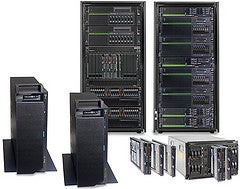

IBM’s Power server architecture has typically been thought of as a technology for really large enterprises and huge data center deployments. IBM now sees a wider deployment future for Power.
IBM this week is introducing eight new Power systems, including a new-entry level system for Big Blue’s big computing platform.
“Mid-sized companies have the same challenges as big companies when it comes to gaining insights from Big Data,” Zarina Stanford, Vice President of Power Systems at IBM, told ServerWatch. “Using a system like POWER that is designed explicitly to handle compute-intensive processing and analytics is what is happening here with our eight new Power system models.”
The new systems include the Power 710, 720, 730, 740, 750 and 760 servers, which all can run on either IBMi, AIX or Linux. IBM is also rolling out two new servers just for Linux in its new PowerLinux 7R1 and 7R2 systems. The smallest Power 710 system is debuting at a price point of just under $6,000.
The 710 Express provides up to an 8-core configuration, while the 730 Express is a dual-socket system that can provide up to 16 cores.  The 720 and 740 Express systems are both 4U servers with two sockets and can deliver 8 cores on the 720 and 16 on the 740. The Power 740 system is a 4U dual-socket system that can scale up to 1024GB of RAM.
The 720 and 740 Express systems are both 4U servers with two sockets and can deliver 8 cores on the 720 and 16 on the 740. The Power 740 system is a 4U dual-socket system that can scale up to 1024GB of RAM.
The PowerLinux 7R1 and 7R2 systems are both 2U systems. The 7R1 can be configured with up to 256 GB of RAM, while the 7R2 can scale to 512 GB of RAM.
All of the new systems include IBM’s new POWER7+ silicon, which was first introduced four months ago by IBM for its largest Power servers. The POWER7 silicon was first introduced in 2010.
As to why IBM has Power servers that are Linux-only in the new portfolio, Stanford said it’s all about customer demand.
As an example, Stanford noted some governments have specific usage requirements to include Linux and open source technologies.
“Having the option to have AIX or IBMi is immaterial for those customers,” Stanford said. “Therefore we put out a Linux only set of servers.”
With the new Power-based servers, IBM is also taking aim at x86. Stanford noted that the IBM Power servers provide additional security and scalable virtualization via advanced technology called PowerVM.
“Every core on a Power Sever can have up to 20 virtual machines inside a core,” Stanford said. “That is powerful virtualization that is not available on x86 or VMware type configurations.”
Sean Michael Kerner is a senior editor at InternetNews.com, the news service of the IT Business Edge Network, the network for technology professionals Follow him on Twitter @TechJournalist.
Property of TechnologyAdvice. © 2025 TechnologyAdvice. All Rights Reserved
Advertiser Disclosure: Some of the products that appear on this site are from companies from which TechnologyAdvice receives compensation. This compensation may impact how and where products appear on this site including, for example, the order in which they appear. TechnologyAdvice does not include all companies or all types of products available in the marketplace.